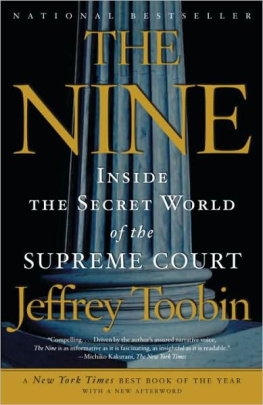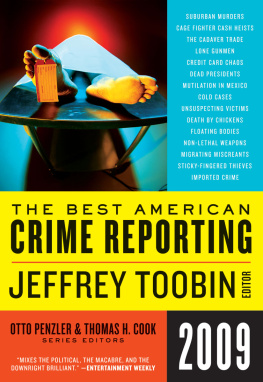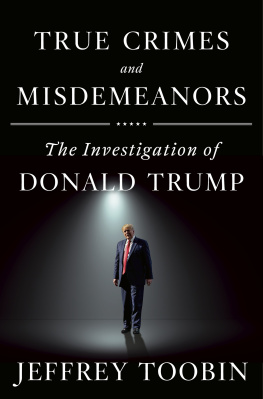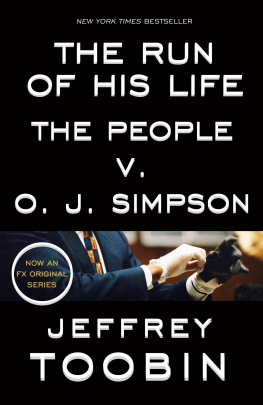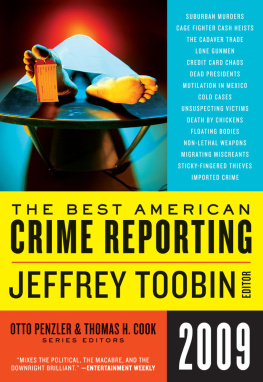
CONTENTS

To Adam
PROLOGUE

THE STEPS
T he architect Cass Gilbert had grand ambitions for his design of a new home for the Supreme Courtwhat he called the greatest tribunal in the world, one of the three great elements of our national government. Gilbert knew that the approach to the Court, as much as the structure itself, would define the experience of the building, but the site presented a challenge. Other exalted Washington edificesthe Capitol, the Washington Monument, the Lincoln Memorialinspired awe with their processional approaches. But in 1928 Congress had designated for the Court a cramped and asymmetrical plot of land, wedged tightly between the Capitol and the Library of Congress. How could Gilbert convey to visitors the magnitude and importance of the judicial process taking place within the Courts walls?
The answer, he decided, was steps. Gilbert pushed back the wings of the building, so that the public face of the building would be a portico with a massive and imposing stairway. Visitors would not have to walk a long distance to enter, but few would forget the experience of mounting those forty-four steps to the double row of eight massive columns supporting the roof. The walk up the stairs would be the central symbolic experience of the Supreme Court, a physical manifestation of the American march to justice. The stairs separated the Court from the everyday worldand especially from the earthly concerns of the politicians in the Capitoland announced that the justices would operate, literally, on a higher plane.
That, in any event, was the theory. The truth about the Court has always been more complicated.
For more than two hundred years, the Supreme Court has confronted the same political issues as the other branches of governmentwith a similar mixed record of success and failure. During his long tenure as chief justice, John Marshall did as much as the framers of the Constitution themselves to shape an enduring structure for the government of the United States. In the decades that followed, however, the Court fared no better than presidents or the Congress in ameliorating the horror of slavery or avoiding civil war. Likewise, during the period of territorial and economic expansion before World War I, the Court again shrank from a position of leadership, mostly preferring to accommodate the business interests and their political allies, who also dominated the other branches of government. It was not until the 1950s and 1960s, and the tenure of Chief Justice Earl Warren, that the Court consistently asserted itself as an independent and aggressive guarantor of constitutional rights.
For the next thirty years, through the tenures of Chief Justices Warren E. Burger and William H. Rehnquist, the Court stood nearly evenly divided on the most pressing issues before it. On race, sex, religion, and the power of the federal government, the subjects that produced the enduring controversies, control of the Court generally belonged to the moderate swing justices, first Lewis F. Powell and then Sandra Day OConnor, who steered the Court in line with their own cautious instinctswhich were remarkably similar to those of the American people. The result was a paradox. Like all their predecessors, the justices belonged to a fundamentally antidemocratic institution. They were not elected; they were not accountable to the public in any meaningful way; their life tenure gave them no reason to cater to the will of the people. Yet the touch-stones of the years 1992 to 2005 on the Supreme Court were decisions that reflected public opinion with great precision. The opinions were issued in the Courts customary language of legal certaintyannounced as if the constitutional text and precedents alone mandated their conclusionsbut the decisions in these cases probably would have been the same if they had simply been put up for a popular vote.
That, now, may be about to change. Through the tense standoff of the Burger and Rehnquist years, a powerful conservative rebellion against the Court was building. It has been, in many respects, a remarkable ideological offensive, nurtured at various times in such locales as elite law schools, evangelical churches, and, most importantly and most recently, the White House. Its agenda has remained largely the same over the decades. Reverse Roe v. Wade and allow states to ban abortion. Expand executive power. End racial preferences intended to assist African Americans. Speed executions. Welcome religion into the public sphere. Because the Court has been so closely divided for so long, conservatives have made only halting progress on implementing this agenda. Now, with great suddenness (as speed is judged by the Courts usual stately pace), they are very close to total control. Within one vote, to be precise.
The Court by design keeps its operations largely secret from the outside world, but there are occasions when its rituals offer a window into its soul. One such day was September 6, 2005, when the justices gathered to say good-bye to William Rehnquist, who had died three days earlier.
Rehnquist had had 105 law clerks in his thirty-three years on the Court, and they all knew him as a stickler for form, efficiency, and promptness. So well before the appointed hour, the group gathered in one of the Courts elegant conference rooms. Seven former clerks and a former administrative assistant had been chosen to carry Rehnquists casket into the building, and they wanted to make sure they did it right. The eight of them gathered around the representatives from the funeral home and asked questions with the kind of intensity and precision that the chief used to demand of lawyers arguing in front of him. Who would stand where? Should they pause between steps or not? Two feet on each step or just one? Only one of them had been a pallbearer before, and he had words of warning for his colleagues. Be careful, said John G. Roberts Jr., who had clerked for then associate justice Rehnquist from 1980 to 1981. Its harder than you think.
At precisely ten the pallbearers and the hearse met on First Street, in front of Cass Gilberts processional steps. The casket was like Rehnquist himselfplain and unadorned. The seven men and one woman grabbed the handles on the pine casket and turned to bring the chief inside the building for a final time. The soft sun of a perfect late-summer morning lit the steps, but the glare off the marble was harsh, nearly oppressive.
As the pallbearers shuffled toward the Court, an honor guard of the other law clerks stood in silence to the left. On the right were the justices themselves. It had been eleven years since there was a new justice, the longest period that the same nine individuals had served together in the history of the Supreme Court. (It had been five decades, since the death of Robert H. Jackson, in 1954, that a sitting justice had died.) The justices lined up according to the Courts iron law of seniority, with the junior member toward the bottom of the stairs and the senior survivor at the top.
The casket first passed Stephen G. Breyer, appointed in 1994 by President Bill Clinton. Such ceremonial duty ill suited Breyer, who still had the gregarious good nature of a Capitol Hill insider rather than the grim circumspection of a stereotypical judge. He had just turned sixty-seven but looked a decade younger, with his bald head nicely tanned from long bike rides and bird-watching expeditions. Few justices had ever taken to the job with more enthusiasm or enjoyed it more.
Next page
